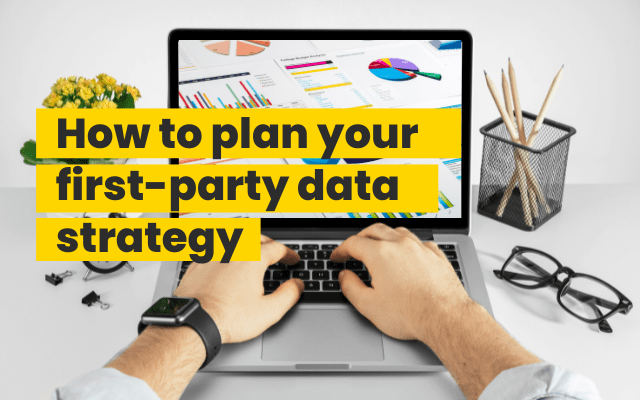Privacy regulations and the phasing out of third-party cookies have made it more important than ever to establish a solid first-party data strategy. Unlike third-party data, first-party data is collected directly from your audience with their consent, making it more reliable, compliant, and valuable for understanding customer behavior.
Here’s a guide on how to plan and implement your first-party data strategy to future-proof your marketing efforts.
Understand the Importance of First-Party Data
First-party data is information collected directly from your customers, such as purchase history, website behavior, email interactions, and customer feedback. It’s both privacy-compliant and accurate, helping you build a closer relationship with your audience. With regulatory changes and consumer expectations around data privacy increasing, relying on first-party data is key to staying compliant and effective in your marketing efforts.
Define Your Goals and Objectives
Your first-party data strategy should be driven by clear goals. Think about what you want to achieve:
Better customer insights
Understand your customers’ preferences and behaviors to personalize their experiences.
Enhanced segmentation
Build targeted campaigns by segmenting your audience based on real data.
Improved ROI
Use data-driven insights to make informed decisions that drive revenue growth. These goals will help determine what type of data you need to collect and how to use it effectively.
Increase customer retention
Create a personalized, engaging experience that keeps your audience coming back. Leveraging data directly from your customers allows you to understand their preferences, behaviors, and needs, enabling you to deliver relevant offers, tailored content, and timely communications. By focusing on customer retention, you not only build long-term relationships but also reduce acquisition costs, increase lifetime value, and strengthen brand loyalty, making your marketing efforts more resilient and effective over time.
Identify Key Data Sources
Identify where you can collect data throughout the customer journey.
Website and app interactions
Track user behavior on your site or app, such as page views, clicks, and time spent on specific pages.
Email engagement
Analyze email metrics, including open rates, click-through rates, and responses to surveys.
Purchase history
Collect data on past purchases to inform recommendations and anticipate future needs.
Customer service interactions
Use feedback from support tickets, reviews, and surveys to understand common issues and preferences.
These sources provide rich, actionable insights that can help you create a more personalized experience for your audience.
Focus on Data Quality and Compliance
To make the most of your first-party data, ensure it’s accurate, up-to-date, and compliant with data protection regulations like GDPR or CCPA. Consider implementing regular data hygiene practices to remove duplicates and outdated information.
Use consent management tools to help ensure that users are aware of what data is being collected and for what purposes. Transparency and trust are essential for building a long-term relationship with your customers.
Implement a Data Collection Framework
Setting up a framework for collecting, storing, and managing your data is crucial. Here’s how to get started.
Use a customer data platform (CDP)
CDPs consolidate data from multiple sources to create a unified customer profile, making it easier to analyze and act on.
Integrate with CRM systems
Your CRM can help centralize data and streamline customer relationship management.
Leverage analytics tools
Tools like Google Analytics 4 allow you to track user interactions while respecting privacy.
Segment and Personalize
With your data in place, start segmenting your audience based on key characteristics or behaviors. By segmenting effectively, you can create highly personalized marketing messages that speak directly to individual needs and preferences.
For example, segment by.
Purchase history
Recommend similar or complementary products based on previous purchases.
Engagement level
Target frequent visitors differently than those who only visit occasionally.
Demographics
Tailor content to different age groups, locations, or interests for relevance.
Build Data-Driven Campaigns
With your segmentation in place, you can launch campaigns that leverage your first-party data to create a seamless and personalized experience. Focus on adding value to your customers with timely, relevant offers and messages.
Personalized email campaigns
Use data-driven insights to create email content that feels relevant and timely.
Retargeting campaigns
Serve targeted ads based on customers’ on-site behavior, such as browsing or abandoned carts.
Product recommendations
Use purchase data to recommend items that align with each customer’s previous choices.
Measure and Optimize
Finally, monitor the effectiveness of your data-driven campaigns by tracking KPIs that align with your goals. Look at metrics such as engagement rates, conversion rates, and ROI to assess your strategy’s impact. Regularly analyze performance to identify areas for improvement and ensure your first-party data strategy remains agile and effective.
Building a first-party data strategy is an investment that will future-proof your marketing efforts. By setting clear goals, collecting high-quality data, and implementing effective segmentation, you can create personalized experiences that foster lasting relationships with your customers. As privacy regulations continue to evolve, a strong first-party data strategy will be your most reliable and compliant path to delivering value to your audience.
Are you ready to take control of your data? Request a trading audit and start building your strategy today with ASK BOSCO®, to unlock the power of first-party data for smarter, more effective marketing.



